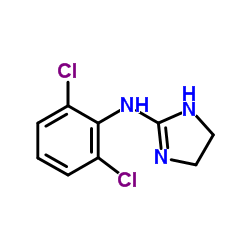Clonidine

Clonidine structure
|
Common Name | Clonidine | ||
|---|---|---|---|---|
| CAS Number | 4205-90-7 | Molecular Weight | 230.094 | |
| Density | 1.5±0.1 g/cm3 | Boiling Point | 319.3±52.0 °C at 760 mmHg | |
| Molecular Formula | C9H9Cl2N3 | Melting Point | 141-142℃ | |
| MSDS | N/A | Flash Point | 146.9±30.7 °C | |
| Symbol |

GHS06 |
Signal Word | Danger | |
|
Enteral absorption and haemodynamic response of clonidine in infants post-cardiac surgery.
Br. J. Anaesth. 113(6) , 964-9, (2014) Clonidine is a useful analgesic-sedative agent; however, few data exist regarding its use in infants after congenital heart disease surgery. We thus aimed to assess the absorption and safety of enterally administered clonidine in this setting.Sixteen infants ... |
|
|
Effect of severe acidosis on vasoactive effects of epinephrine and norepinephrine in human distal mammary artery.
J. Thorac. Cardiovasc. Surg. 147(5) , 1698-705, (2014) Acidosis is a very common pathologic process in perioperative management. However, how to correct severe acidosis to improve the efficacy of vasoconstrictors in hemodynamically unstable patients is still debated. The present study investigated whether severe ... |
|
|
Patient education and self-care for the management of jaw pain upon awakening: a randomized controlled clinical trial comparing the effectiveness of adding pharmacologic treatment with cyclobenzaprine or tizanidine.
J. Oral Facial Pain Headache 28(2) , 119-27, (2014) To compare the effectiveness of adding cyclobenzaprine, tizanidine, or placebo to patient education and a self-care management program for patients with myofascial pain and specifically presenting with jaw pain upon awakening.Forty-five patients with a diagno... |
|
|
Prevention of acute kidney injury using vasoactive or antiplatelet treatment: three strikes and out?
JAMA 312(21) , 2221-2, (2014)
|
|
|
Perioperative aspirin and clonidine and risk of acute kidney injury: a randomized clinical trial.
JAMA 312(21) , 2254-64, (2014) Acute kidney injury, a common complication of surgery, is associated with poor outcomes and high health care costs. Some studies suggest aspirin or clonidine administered during the perioperative period reduces the risk of acute kidney injury; however, these ... |
|
|
Myocardial infarction risks remain for patients undergoing noncardiac elective surgery.
JAMA 311(19) , 1955-6, (2014)
|
|
|
The yin and yang of perioperative medicine.
N. Engl. J. Med. 370(16) , 1554-5, (2014)
|
|
|
Combination of clonidine sedation and spontaneous breathing-pressure support upon acute respiratory distress syndrome: a feasibility study in four patients.
Acta Anaesthesiol. Belg. 63(3) , 127-33, (2012) As alpha-2 agonists preserve ventilator drive, patients presenting with acute respiratory distress syndrome (ARDS, Pa02/FiO2 < 200) were managed using sedation with an alpha-2 agonist, clonidine, combined to spontaneous ventilation (SV) + pressure support ven... |
|
|
Status dystonicus: a practice guide.
Dev. Med. Child Neurol. 56(2) , 105-12, (2014) Status dystonicus is a rare, but life-threatening movement disorder emergency. Urgent assessment is required and management is tailored to patient characteristics and complications. The use of dystonia action plans and early recognition of worsening dystonia ... |
|
|
Disease mechanisms and clonidine treatment in adolescent chronic fatigue syndrome: a combined cross-sectional and randomized clinical trial.
JAMA Pediatr. 168(4) , 351-60, (2014) Chronic fatigue syndrome (CFS) is a disabling condition with unknown disease mechanisms and few treatment options.To explore the pathophysiology of CFS and assess clonidine hydrochloride pharmacotherapy in adolescents with CFS by using a hypothesis that patie... |